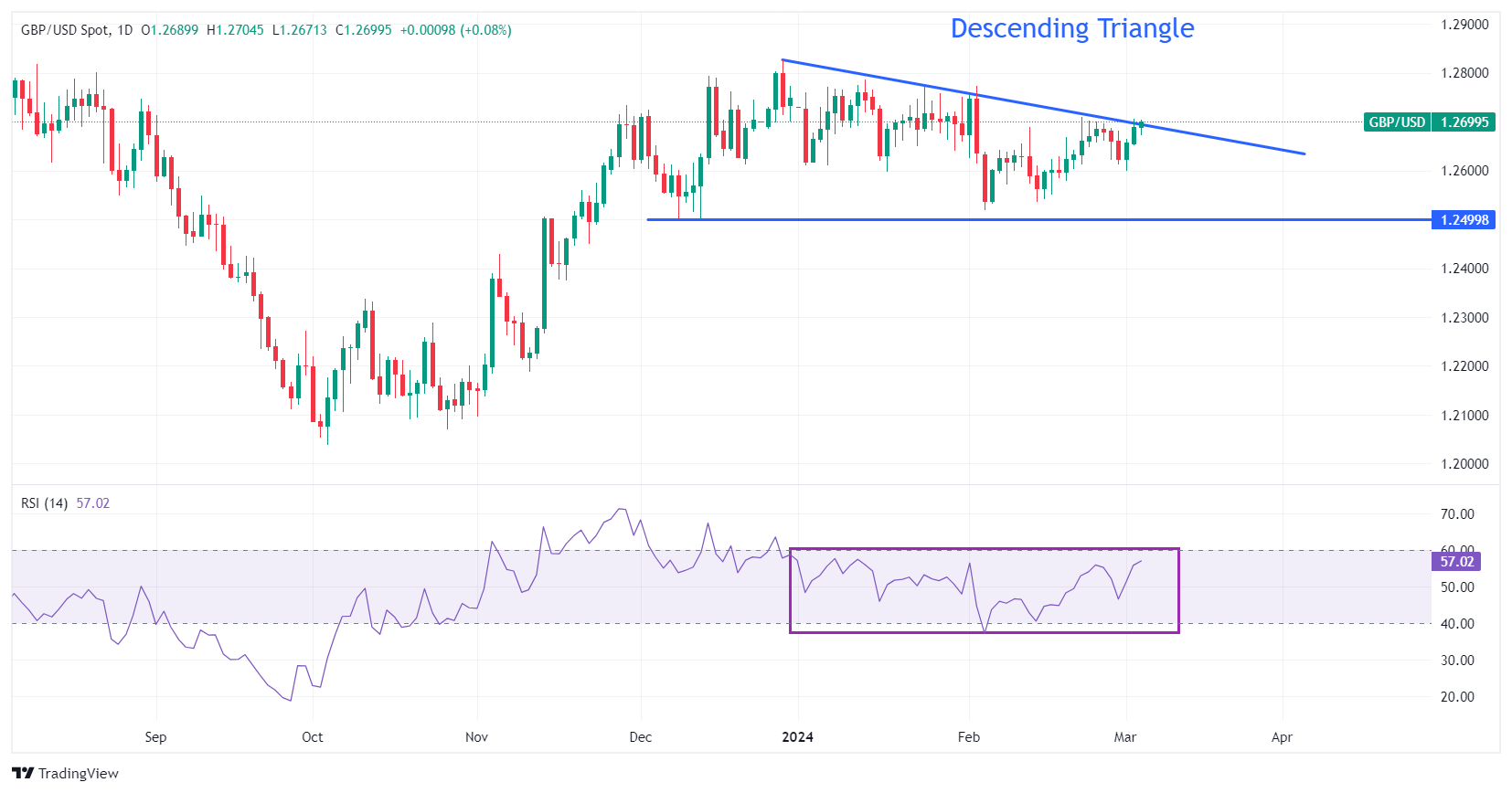Pound Sterling rebounds strongly ahead of UK’s budget, Fed Powell’s testimony.
Limited exposure to fiscal stimulus in the UK’s spring budget would reinforce hopes of BoE rate cuts.
Investors await the US PMI data for fresh guidance.
The Pound Sterling (GBP) advances to the crucial resistance of 1.2700 in Tuesday’s early New York session. The GBP/USD pair gains ahead of the United Kingdom’s Spring budget, to be outlined by Chancellor Jeremy Hunt on Wednesday. The scope of fiscal measures will be a balancing act for Jeremy Hunt as the UK economy faces a stubborn inflation outlook and deteriorating growth forecasts. “We’ve always said we would only cut taxes in a way that’s responsible and prudent,” Hunt said on Sunday, according to BBC News
Limited scope for tax cuts would escalate hopes of early rate cuts by the Bank of England (BoE), a scenario that could weigh on the Pound Sterling. However, large and unfunded fiscal stimulus will deepen fears of inflation remaining persistent.
Meanwhile, a dismal market sentiment ahead of Federal Reserve Chair Jerome Powell’s testimony before Congress, also due on Wednesday, and an array of United States economic data this week has brought some relief for the US Dollar.
In today’s session, investors will focus on the US S&P Global and ISM Services PMIs, which will be published at 14:45 GMT and 15:00 GMT, respectively.
Daily digest market movers: Pound Sterling recovers strongly while US Dollar retreats
The Pound Sterling rebounds to near the round-level resistance of 1.2700 ahead of the United Kingdom’s Spring budget and packed United States economic calendar.
The market participants will keenly focus on the Spring budget to be announced by Chancellor Jeremy Hunt. An indication of higher fiscal stimulus through tax cuts, a decline in national insurance rates, and significant public spending plans against revenue-raising tools would weaken hopes of early rate cuts by the Bank of England as fiscal stimulus could fuel inflationary pressures.
The Conservative government’s plan is expected to lean towards spurring growth to avoid the economy falling into a recession again. However, a big stimulus package isn’t likely.
BoE policymakers have indicated that the technical recession observed in the second half of 2023 was shallow.
The economy is probably back on track for growth as Retail Sales and PMIs are improving meaningfully. However, an array of liquidity measures is required to confirm that the economy must not get derailed from the path of recovery.
On the contrary, the limited scope of fiscal measures could prompt chances of early rate cuts by the BoE. Markets expect the BoE to start reducing interest rates in August, when inflation is expected to return to the 2% target before increasing again.
Meanwhile, the S&P Global/CIPS has reported dismal Services PMI data for February. Services PMI drops to 53.8 from expectations and the prior reading of 54.3.
The US Dollar falls back to a two-day low near 103.70 ahead of Federal Reserve Chair Jerome Powell’s testimony before Congress on Wednesday and a bunch of US economic data such as the ISM Services PMI, ADP Employment Change, JOLTS Job Openings, and the Nonfarm Payrolls.
Powell is expected to warn about the potential risks of early rate cuts, reiterating the need for more evidence to confirm that inflation will return to the 2% target.
Technical Analysis: Pound Sterling advances to 1.2700

The Pound Sterling attempts a decisive break of the downward-sloping border of the Descending Triangle pattern formed on a daily time frame, placed from December 28 high at 1.2827. A decisive break above the same could result in a sharp upside move. The horizontal support of the aforementioned chart pattern is plotted from December 13 low near 1.2500.
Usually, a Descending Triangle pattern exhibits indecisiveness among market participants, but it has a slight downside bias due to lower highs and flat lows.
The 14-period Relative Strength Index (RSI) oscillates inside the 40.00-60.00 range, indicating a sharp volatility contraction.
BoE FAQs
The Bank of England (BoE) decides monetary policy for the United Kingdom. Its primary goal is to achieve ‘price stability’, or a steady inflation rate of 2%. Its tool for achieving this is via the adjustment of base lending rates. The BoE sets the rate at which it lends to commercial banks and banks lend to each other, determining the level of interest rates in the economy overall. This also impacts the value of the Pound Sterling (GBP).
When inflation is above the Bank of England’s target it responds by raising interest rates, making it more expensive for people and businesses to access credit. This is positive for the Pound Sterling because higher interest rates make the UK a more attractive place for global investors to park their money. When inflation falls below target, it is a sign economic growth is slowing, and the BoE will consider lowering interest rates to cheapen credit in the hope businesses will borrow to invest in growth-generating projects – a negative for the Pound Sterling.
In extreme situations, the Bank of England can enact a policy called Quantitative Easing (QE). QE is the process by which the BoE substantially increases the flow of credit in a stuck financial system. QE is a last resort policy when lowering interest rates will not achieve the necessary result. The process of QE involves the BoE printing money to buy assets – usually government or AAA-rated corporate bonds – from banks and other financial institutions. QE usually results in a weaker Pound Sterling.
Quantitative tightening (QT) is the reverse of QE, enacted when the economy is strengthening and inflation starts rising. Whilst in QE the Bank of England (BoE) purchases government and corporate bonds from financial institutions to encourage them to lend; in QT, the BoE stops buying more bonds, and stops reinvesting the principal maturing on the bonds it already holds. It is usually positive for the Pound Sterling.
Information on these pages contains forward-looking statements that involve risks and uncertainties. Markets and instruments profiled on this page are for informational purposes only and should not in any way come across as a recommendation to buy or sell in these assets. You should do your own thorough research before making any investment decisions. FXStreet does not in any way guarantee that this information is free from mistakes, errors, or material misstatements. It also does not guarantee that this information is of a timely nature. Investing in Open Markets involves a great deal of risk, including the loss of all or a portion of your investment, as well as emotional distress. All risks, losses and costs associated with investing, including total loss of principal, are your responsibility. The views and opinions expressed in this article are those of the authors and do not necessarily reflect the official policy or position of FXStreet nor its advertisers. The author will not be held responsible for information that is found at the end of links posted on this page.
If not otherwise explicitly mentioned in the body of the article, at the time of writing, the author has no position in any stock mentioned in this article and no business relationship with any company mentioned. The author has not received compensation for writing this article, other than from FXStreet.
FXStreet and the author do not provide personalized recommendations. The author makes no representations as to the accuracy, completeness, or suitability of this information. FXStreet and the author will not be liable for any errors, omissions or any losses, injuries or damages arising from this information and its display or use. Errors and omissions excepted.
The author and FXStreet are not registered investment advisors and nothing in this article is intended to be investment advice.
>>> Read full article>>>
Copyright for syndicated content belongs to the linked Source : FXStreet – https://www.fxstreet.com/news/pound-sterling-edges-down-amid-risk-off-mood-uks-spring-budget-in-focus-202403050759
















![[News] Japan Develops 10nm Nanoimprint Technology, with Potential to Tackle EUV Bottleneck – TrendForce](https://earth-news.info/wp-content/uploads/2025/12/329851-news-japan-develops-10nm-nanoimprint-technology-with-potential-to-tackle-euv-bottleneck-trendforce-360x180.jpg)














